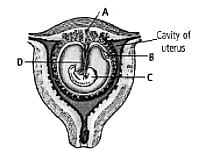Test: Pregnancy and Embryonic Development (November 5) - NEET MCQ
10 Questions MCQ Test Daily Test for NEET Preparation - Test: Pregnancy and Embryonic Development (November 5)
In a normal pregnant woman, the amount of total gonadotropin activity was assessed. The result expected was.
Which of the following hormones is not a secretion product of human placenta?
| 1 Crore+ students have signed up on EduRev. Have you? Download the App |
Fill in the blanks in the given statement and select the correct option.
A. The developmental stage of an animal passed in the mother's womb is called (i) .
B. The outer layer of blastula is called (ii) . It does not take part in the formation of (iii) .
C. (iv) is the first germ layer formed from the inner cell mass by differentiation.
A. The developmental stage of an animal passed in the mother's womb is called (i) .
B. The outer layer of blastula is called (ii) . It does not take part in the formation of (iii) .
C. (iv) is the first germ layer formed from the inner cell mass by differentiation.
Fetus gets nourishment and oxygen through
Identify the labelled parts A−D in the given figure of human foetus within the uterus.


The main function of trophoectoderm in mammalian embryo is
Urine test during pregnancy determines the presence
The early stage human embryot distinctly possesses
Structure connecting the foetus to placeiita is
Select the option that correctly fills up the blanks in the given paragraph.
After one month of pregnancy, the embryo's (i) is formed. By the end of the (ii) month of pregnancy, the fetus develops limbs and digits. By the end of (iii). most of the major organ systems are formed, for example, the limbs and external genital organs are well-developed. By the end of (iv). the body is covered with fine hair, eye-lids separate, and eyelashes are formed.
|
12 docs|366 tests
|

















